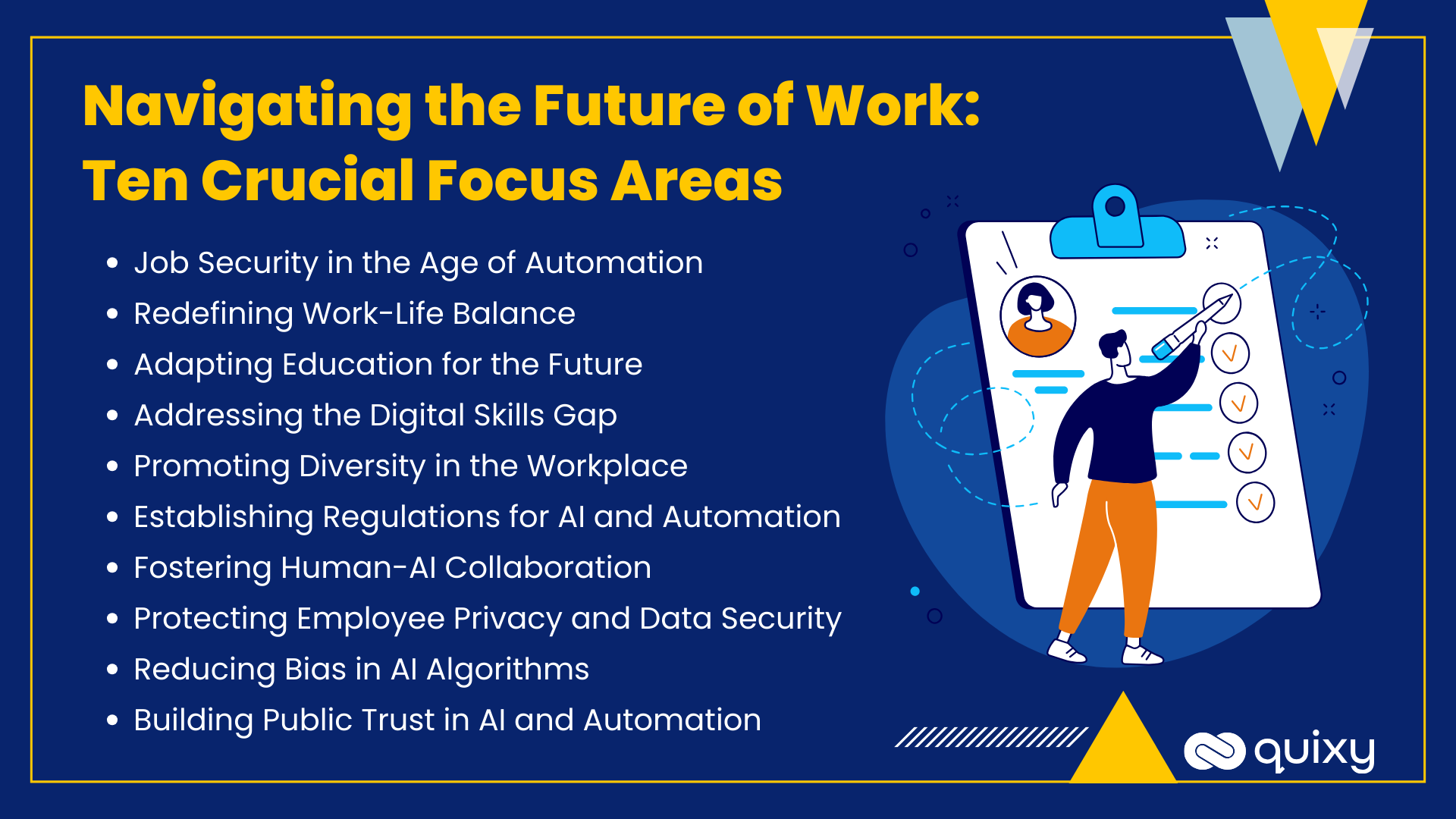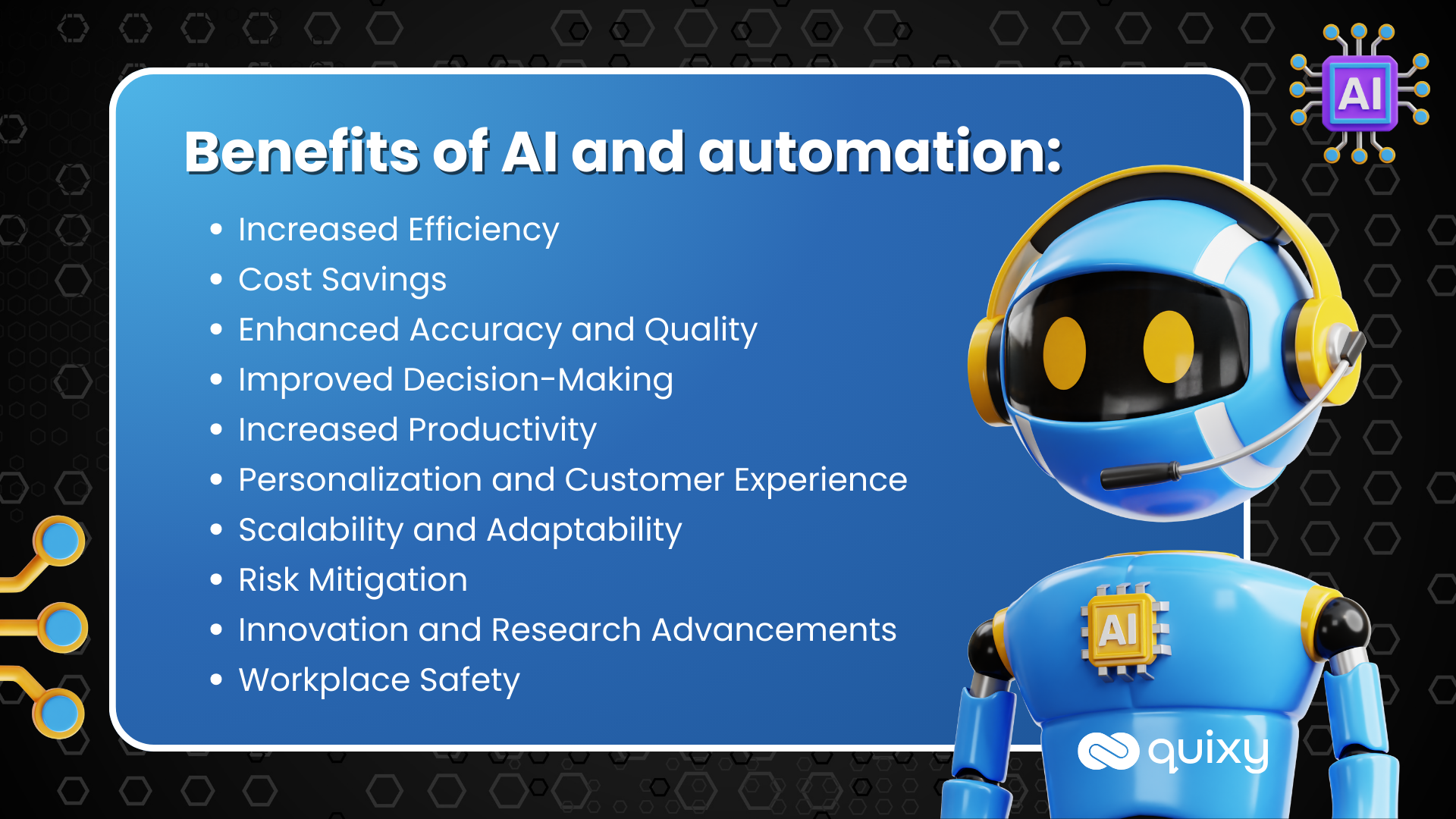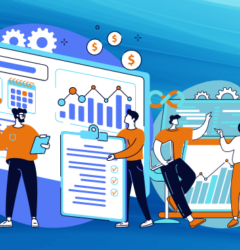
One important trend of our day is the fact that AI and automation are incorporated into the workforce, altering both the nature of work and the skills, structures, and dynamics that uphold it. We are moving further into the technology revolution. Hence, understanding its full implications is becoming increasingly important. Besides the ethics issues they raise, this article also explores the considerable effects of AI and automation on employment positions and the skills required. There will also be ten key areas that must be addressed immediately to optimize human potential and ensure that everyone has equal opportunity to contribute towards a new future of work.
Understanding AI and Automation
Technology is taking over a lot of sectors including No-Code AI and automation in today’s world driven by technology.
Marrying automation with AI is a big leap that enhances creativity, productivity, and problem-solving skills. Nonetheless, this progress does come with its own set of challenges. The interaction between technological influences and human roles and duties at work is a complex phenomenon that cannot simply be separated from itself. At the same time, they present opportunities in terms of efficiency and innovation and challenges about employment displacement, skill development, and ethical considerations.
Also Read: AI Automation 101: What It Is & How Businesses Are Using It
Navigating the Transforming Landscape of Work
The intricate implications of artificial intelligence and workflow automation on employment are more than just important; they are absolutely vital as we advance deeper in this era. These technologies are not just tools. They are catalysts that spark changes in different industries. Sectors are also grappling with unprecedented changes in job roles, skill sets, and organizational structure as a result of increased productivity and creativity caused by AI and automation.
The process of reinventing and re-imaging what a job means is taking place at a fast rate. AI and automation are taking over various job positions while new professions are emerging. Tomorrow’s occupations require transitional skill sets that entail adaptability, technology literacy, problem-solving, and emotional intelligence.
It is not an understatement to suggest that AI and automation are changing the workforce rules landscape. It is important to be prepared to understand and respond to the complicated implications of these technologies in this time of change. It implies creating an atmosphere where the enterprises’ innovativeness, learning, and change are considered important. It also highlights the importance of upskilling and reskilling for workers to be able to remain competitive in the labor market. It highlights the need for a regulatory regime that weighs against technological, social, and economic implications in decision-making.
Also Read: Explore the Power of Artificial Intelligence: What AI can or cannot do?
Effects of AI and Automation on Employment & Skills
This is a period of transformation characterized by problems and opportunities accompanying AI and automation. For example, these technologies enhance accuracy and efficiency, reduce processes, and lower costs. Automation is increasingly improving productivity across the board, from manufacturing to customer service, through the speed and accuracy with which it can carry out repetitive operations.
On the flip side, this improved efficiency has its own disadvantages, including job displacement. Automation has become prevalent across jobs historically involving human workers, resulting in fears of widespread unemployment and economic inequalities, especially related to routine, repetitive jobs. Workers are most prone in such sectors as manufacturing, transport, and simple administrative ones.
However, this story also has another side. Although technology replaces some work responsibilities, it also stimulates the emergence of new occupations. New positions are evolving where technology meets creativity and human interaction with automation and AI yet to walk in fully. The new professions that the age of automation and AI has created include data scientists, AI ethicists, and user experience designers.
Also Read: 30+ Top AI Tools for Productivity to Ignite Efficiency
Changes in Skill Requirements
At the same time, employment positions and the skill sets needed in the AI/automation-driven workforce are also changing. It’s a high-demand technical skill regarding software development, machine learning, and analytics. Soft talents such as problem-solving, creativity, and emotional intelligence are becoming more and more important for human-oriented workplaces.
The change underscores the importance of a tech-savvy workforce that is well-versed in AI and automation. The ability to adapt, learn, and acquire new skills is a critical determinant for career longevity and advancement in this environment.
This shift requires the engagement of businesses. Organizations should also strive to promote a conducive learning and skills-acquisition atmosphere. The skills gap must be addressed through investments in training courses, seminars, and other educational resources will enable workers to catch up with the changing characteristics of the labor market.
It is important for a proactive, educated approach to managing job displacement and changing skill requirements as AI and automation continue to change the workforce. Therefore, governments, businesses, educational institutions, and individuals need to work together as a multi-stakeholder coalition to ensure that the transition is not only technologically advanced but also socially just and morally right.
The following are inherent challenges:
A. Ethical Considerations of AI and Automation
AI and automation have changed the working and personal world which poses many ethical issues. Therefore, due to their widespread use, decision-making capacity, and influence on our social norms, a comprehensive assessment of the ethical underpinning of these technologies is imperative. This involves fairness, openness, privacy, and accountability.
Machine learning models are especially accused of being biased due to the biases that come from the teams or the training data they were developed with. This is likely to lead to unfair practices and discrimination which are morally and legally problematic. This could include, for example, AI employment applications that inadvertently exclude some demographic groups, leading to unfair disparities.
The stakeholders must be able to know the AI operations and its decision-making process to understand and trust the technology. It’s important for the validity and the justification of AI and ensuring it’s responsible for decisions made and actions taken.
Also Read: Top 10 AI Skills for Success: Mastering the Future
B. Inequality and Job Polarization
AI and automation a powerful tools for efficiency and creativity, but they also pose serious challenges of employment polarization and wealth inequality. These technologies can widen the gap between high-skill and low-skill workers.
The demand for highly trained people who can use, make, and manage AI and automated systems is expected to increase with higher wages and better jobs. The automation of such jobs as a result could lead to the loss of jobs and frozen wages for low-skill workers.
This could worsen income inequity by fostering social and economic inequalities if the advantages of automation and AI are not distributed equitably. To solve this, governments, corporations, and civil society must work hand in hand to ensure these technologies result in a more even distribution of the economic benefits and support structures for the affected individuals.
C. Retraining and Upskilling the Workforce
In this regard, the contemporary workforce requires to be continually learning and adapting since AI and automation are changing job roles and skills. Technology is a process of constant evolution. It makes sure that certain types of skills become obsolete. At the same time, it brings in new skills at an unprecedented pace. As such, employees should be ready to shift their skills in this direction.
This development is not solely on the employees. Businesses and organizations will lead the endeavor through comprehensive retraining and upskilling schemes. These need to be tailor-made to equip the workforce with the necessary skill sets to move with the world augmented by AI and automation.

Ten Things to Solve For in the Future of Work
Here are the ten pivotal areas that stand as cornerstones for ensuring that the integration of AI and automation into the workforce is not only seamless but also equitable, ethical, and human-centric. Each point is elaborated to provide insights and suggest pathways to address the associated challenges effectively.

A. Ensuring Job Security in the Age of Automation
When automation hits, it’s important to have safety nets and other work options for people. This will reduce the bad social and economic effects it causes. To make the transition easier, there should also be programs in place and support systems that can help workers. These aid in finding a new job while still being mindful of their unique situation.
B. Redefining Work-Life Balance in a Digitally-Driven World
With the rise of remote and flexible work, it’s becoming more important for us to find new ways to set boundaries and protect mental health. Businesses need to implement new programs, or change existing ones, with the mindset that work is no longer 9-5 in an office. Employee connection and support need to be at the forefront of these wellness programs so people feel appreciated, supported, and like they have a voice even at a distance.
C. Adapting Education and Training Systems for the Future
With in-person classes being dropped left and right and replaced with online lectures it becomes harder for students to get valuable insights. The education system needs to adopt new practices that are in line with changing workforce demands. These can include things like real-world applications and incorporating technology trends into instructional content.
D. Addressing the Digital Skills Gap
Governments, corporations, and educational institutions must work together as well. Doing so will help them offer specialized training programs for the digital workforce. The skills gap has been growing too wide lately and this is how we can close it back up again. A successful strategy can be formed by understanding specific skill deficits.
Also Read: Staying Ethical in the AI Era: A Data-Driven Guide
E. Promoting Diversity and Inclusivity in the Workplace
In the workplace, everyone deserves equal opportunity. So companies need to focus on diversity and inclusivity when creating their organizational culture. Only then will everyone feel fairly represented. But this isn’t where it stops. Change will always be needed so organizations should continuously monitor and review their diversity programmes.
F. Establishing Regulations and Policies for AI and Automation
When AI and automation came into the picture, it became clear that we needed a way to protect people and society. We can do this by understanding how to navigate them. Solving this issue would mean essentially creating global guidelines and principles that go beyond borders.
G. Fostering Human-AI Collaboration
Even with all their strength, there are still limitations with AI and humans. The fusion of the two promises extraordinary innovation and productivity though. By combining them together in a collaborative way, we can make strides towards new limits never seen before.
Also Read: A Realistic Look at Automation Struggles in Manufacturing Industry
H. Protecting Employee Privacy and Data Security
One thing that’s always been an issue is privacy. In this new era of data, it could be one of our largest hurdles. That’s why organizations should take extra steps to increase transparency around data usage and security measures. If not done already, these processes should be made more stringent.
I. Reducing Bias in AI Algorithms
The best decisions come from different viewpoints and skills. This is especially true for AI systems. When developing them, it’s important to have a variety of inputs so no single bias is targeted or promoted.
J. Building Public Trust in AI and Automation
Transparency, accountability, and moral behavior are crucial for maintaining public trust. Building and sustaining this trust requires open communication, education, and engagement techniques. Inviting the public to participate in regulatory and policy-making processes can also promote a sense of inclusion and ownership, which will increase confidence in the use of automation and AI.
Benefits of AI and Automation

A. Increased Efficiency
AI and automation streamline processes, reducing manual effort and time required to perform tasks, and leading to enhanced operational efficiency.
B. Cost Savings
Automation lowers labor costs, minimizes errors, and optimizes resource utilization, resulting in significant cost savings for businesses.
C. Enhanced Accuracy and Quality
AI-driven systems perform tasks with precision, minimizing human errors and maintaining consistent, high-quality outputs.
Also Read: Caddie by Quixy: The AI Assistant Empowering Smarter Decisions
D. Improved Decision-Making
AI analyzes vast amounts of data swiftly, providing insights that aid in informed decision-making, leading to better outcomes.
E. Increased Productivity
Automation allows employees to focus on more strategic tasks, boosting overall productivity and output within organizations.
F. Personalization and Customer Experience
AI enables personalized customer interactions and experiences by analyzing customer data, leading to improved satisfaction and loyalty.
G. Scalability and Adaptability
Automated systems can scale operations seamlessly, adapting to changing demands and business needs efficiently.
H. Risk Mitigation
AI helps in identifying and mitigating risks by analyzing patterns and anomalies, thus enhancing risk management strategies.
J. Innovation and Research Advancements
AI accelerates innovation by facilitating research, development, and the creation of new solutions across various industries.
K. Workplace Safety
Automation reduces human involvement in hazardous tasks, contributing to a safer work environment and minimizing workplace accidents.
These benefits collectively contribute to a more agile, efficient, and competitive landscape across industries that embrace AI and automation technologies.
Also Read: The Secrets of App Development: Building Excellence
How Quixy AI Automation can help work environment?
Currently, Quixy Automation and AI are revolutionizing the workflow environment to achieve high productivity and efficiency. Features like Sandbox Environments, AI Caddie, and the ER Diagram View are used in managing teams, levearage manpower and enhancing human potential.
Here’s how Quixy reshapes the workflow environment and workforce utilization:
Seamless Workflow Automation with Sandbox Environments
It allows organizations to implement new workflow operations. Testing and troubleshooting can be performed safely, enabling teams to develop and refine processes faster. It allows teams to develop and refine processes faster by automation
Enhanced Decision-Making with AI-Powered Caddie
Can streamline workflows by offering intelligent recommendations for application development and data organization. This reduces manual errors and enhances decision-making processes with a focus on innovation and creativity.
ER Diagram View with Data Clarity
It helps in simplifying complex data relationships in easy way. ER diagram also promotes efficient data management, reducing human intervention and ensuring consistency. So employees can focus on process optimization and drive the organization towards growth.
Quixy Workflow automation reduces the burden of repetitive tasks, allowing manpower to be used for roles that drive creativity, strategic thinking, and human connection. In turn, we help create a work environment where technology and people can complement each other and enhance human potential by serving mankind.
Conclusion
AI and automation are not merely technology fads; they are also the driving forces behind a major shift in society. The mentioned difficulties must be addressed collectively, necessitating multi-stakeholder cooperation and promote a work environment where technology and people coexist. So we can collectively lead the future of work in the direction of inclusivity, equity, and prosperity. Learn more about Quixy & how to implement AI automation in your work environment by scheduling a demo call.And Discover how Quixy AI-powered solutions can revolutionize your operations.
Frequently Asked Questions (FAQs)
Q. What is the role of AI in automation?
AI plays a crucial role in automation by enabling machines to learn, adapt, and perform tasks without explicit programming. It enhances efficiency, accuracy, and decision-making in automated processes.
Q. What are the key benefits of using AI in automation?
AI-powered automation offers increased productivity, cost savings, reduced errors, improved decision-making, scalability, and the ability to handle complex tasks efficiently.
Q. How does AI impact job roles in automated industries?
AI and automation can transform job roles by automating routine tasks, and creating new job opportunities in AI development, data analysis, and decision-making while also demanding upskilling to adapt to evolving technologies.
Q. What industries benefit the most from AI-driven automation?
Industries such as manufacturing, healthcare, finance, logistics, customer service, and agriculture benefit significantly from AI-driven automation, streamlining operations and improving efficiency.
Q. How can businesses prepare for the future of AI and automation?
Businesses can prepare by investing in employee training, ensuring ethical AI use, fostering a culture of innovation, adapting to changing skill requirements and staying updated on technological advancements.
Subscribe
Login
Please login to comment
0 Comments
Oldest















